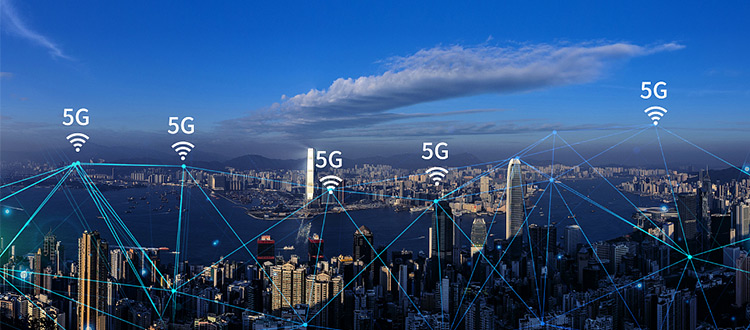The fifth generation of mobile communication technology (English: 5th generation mobile networks or 5th generation wireless systems, 5th-Generation, referred to as 5G or 5G technology) is the latest generation of cellular mobile communication technology, also following 4G (LTE-A, WiMax), 3G ( The extension after UMTS, LTE) and 2G (GSM) systems. The performance goals of 5G are high data rates, reduced latency, energy savings, cost reduction, increased system capacity, and large-scale device connections. The first phase of the 5G specification in Release-15 is to adapt to early commercial deployments. The second phase of Release-16 will be completed in April 2020 and will be submitted to the International Telecommunication Union (ITU) as a candidate for IMT-2020 technology. The ITU IMT-2020 specification requires a speed of up to 20 Gbit/s, which can achieve wide channel bandwidth and large-capacity MIMO.

1. Data rate
Data rate metrics can be divided into the following points
a) Aggregate data rate or area capacity
Aggregated data or area capacity refers to the total data rate that the communication system can support at the same time, and the unit is bits/s per unit area. It is equivalent to the previous-generation 4G communication system, and the aggregate data rate of 5G is required to be increased by more than 1,000 times.
b) Edge rarte
The edge rate refers to the worst transmission rate that the user may encounter when the user is at the edge of the system, that is, the lower limit of the data. And because the 5% of the users with the worst transmission rate are generally taken as the standard to measure the edge rate, the edge rate is also called the 5% rate.
For this indicator, the 5G target is 100Mbps to 1Gbps, which is at least 100 times higher than the typical 4G edge rate requirement of 1Mbps.
c) Peak rate, as the name implies, refers to the maximum rate a user can achieve under the best conditions.
2. Delay
The round-trip delay of the current 4G system is 15ms, of which 1ms is used by the base station to allocate channels to users and the necessary signaling overhead generated by the access mode. Although the 15ms of 4G is quite sufficient compared to most services. But with the development of science and technology, some devices that emerged later require lower latency, such as mobile cloud computing and the networking of wearable devices.
To this end, new architectures and protocols are needed.
3. Energy cost
As we move to 5G networks, the energy consumption of communications should become lower and lower. However, as mentioned earlier, the user's data rate needs to be increased by at least 100 times, which requires that the energy consumption per bit of information transmitted in 5G needs to be reduced by at least 100 times. However, a large part of the energy consumption now lies in the complex signaling overhead, such as the backhaul signal sent back to the base station by the network edge base station. In the 5G network, this overhead will be more due to the denser deployment of base stations. Therefore, 5G must improve energy utilization.
4. Access equipment characteristics
5G networks need to have stronger service capabilities and be able to access more users at the same time. With the development of machine-to-machine (device-to-machine) communication technology, a single macro cell should be able to support more than 1000 devices with low transmission rates, while still supporting ordinary high-speed devices. .
The technology needed for 5G
Ultra-dense heterogeneous network, self-organizing network, D2D (device-to-device) communication, M2M (machine-to-machine) communication, software-defined wireless network, information center network, content distribution network, mobile cloud computing, software-defined network /Network function virtualization, context-aware technology
5G development trend characteristics
1. The spectrum utilization rate is greatly improved, and high-frequency spectrum resources are used more
At present, the spectrum resources used for mobile communication are very limited, and the spectrum resources in our country are allocated to various radio departments in a fixed manner, which further leads to the unbalanced and low utilization of resources. Compared with 4G networks, 5G's spectrum utilization rate will be greatly improved, and high-frequency band resources will be appropriately used to overcome this severe problem.
2. Support business personalization to a greater extent and provide comprehensive information services
People's demand for mobile communication tends to be personalized and hierarchical, and they can leave the communication network at all times in their lives. One of the goals of the 5G network is to build a more complete network architecture and improve the ability to support various emerging services, so as to create a new communication life for users.
3. The communication rate is greatly improved
With the rapid development of the information age, people are demanding higher and higher rates of information acquisition, which poses a great challenge to the transmission rate of communication networks. The theoretical data transmission rate of the 5G network reaches one hundred times that of the 4G standard. The highest peak rate of 4G is 1G, while 5G can reach 10G. This means that in a 5G network environment, an ultra-high-definition picture quality movie can be downloaded within 1 second. At the same time, the 5G network will also exhibit features such as low latency, high reliability, and low power consumption in transmission.
4. Green and energy saving
In the 5G network, while ensuring the quality of communication, effective green energy-saving technologies will be adopted to reduce network loss and control energy consumption within a certain range. In the future communication process, operators can adjust resource distribution according to real-time communication conditions to save network energy.
At present, 5G research is still in its infancy, and there are still many technical problems to be solved. With the deepening of its research process, in the future, 5G will inevitably bring a brand-new communication experience to users and comprehensively promote the development of the information age.







